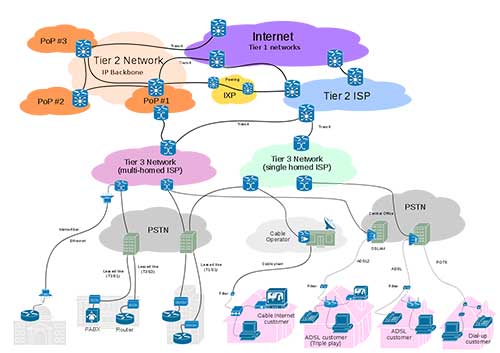What is the Internet?
Let us consider a point-to-point communication (for example, computer A to computer B). This communication only requires a means to convey the message: a line, a radio transmission, etc. If a third computer C joins the communication, then we need to increase point to point connections between A and B, A and C, and B and C.
What happens if more and more nodes join the communication network? Imagine the Internet with millions of users. In this case, point-to-point connections become unfeasible. To avoid this problem, intermediate devices come into place, like routers. In this way, Internet users only require a single communication link towards the router, which will be responsible for delivering the message to its final destination.
Thus, the Internet could be seen as a set of “nuts and bolts”.

Click to enlarge
Figure 1 Internet’s “nuts and bolts” view
Diagram showing how customers connect to ISP's... by Ludovic ferre... from Wikipedia CC BY-SA 3.0
In a simplified view of the Internet, the main components are:
Computing devices:
- Hosts = End systems
For example: Your PC, a storage server in the cloud or your neighbour’s smartphone. - Running network applications
For example: Skype, Instagram or, simply, your email inbox.

Picture of a computer keyboard
Communication links:
- Fibre, copper, radio, satellite, etc.
- Mainly characterised by their transmission rate or bandwidth

Picture of an Ethernet cable
Forwarders or network devices:
- Routers and switches
- In charge of forwarding packets (chunks of data)

Picture of a home router





